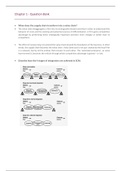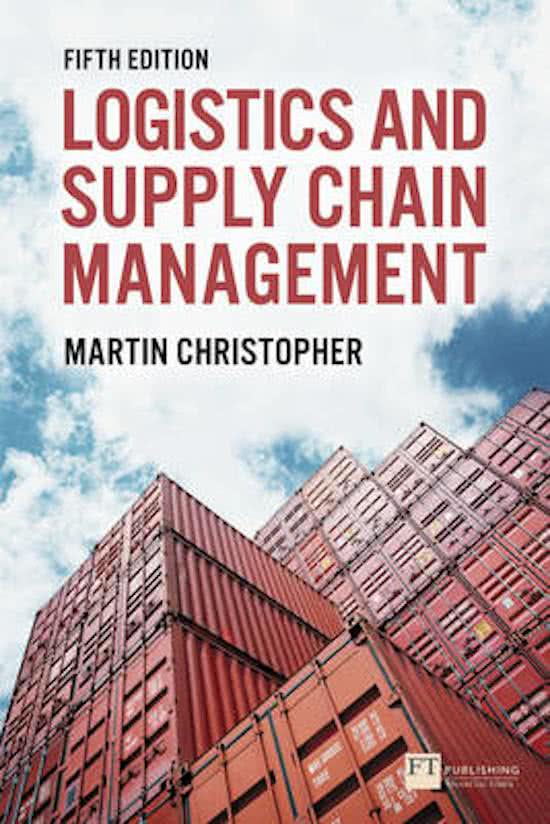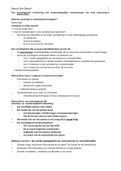Chapter 1 - Question Bank
• When does the supply chain transform into a value chain?
• The value chain disaggregates a firm into its strategically relevant activities in order to understand the
behavior of costs and the existing and potential sources of differentiation. A firm gains competitive
advantage by performing these strategically important activities more cheaply or better than its
competitors.
• The effect of outsourcing is to extend the value chain beyond the boundaries of the business. In other
words, the supply chain becomes the value chain. Value (and cost) is not just created by the focal firm
in a network, but by all the entities that connect to each other. This ‘extended enterprise’, as some
have termed it, becomes the vehicle through which competitive advantage is gained – or lost.
• Describe how the 4 stages of integration are achieved in SCM.
, • Discuss the most pressing current issues in today’s supply chain management.
• The new rules of competition: Instead, the need to create value delivery systems that are more
responsive to fast-changing markets and are much more consistent and reliable in the delivery of
that value requires that the supply chain as a whole be focused on the achievement of these goals.
In the past, the ground rules for marketing success were obvious: strong brands backed up by
large advertising budgets and aggressive selling. This formula now appears to have lost its power.
Instead, the argument is heard, companies must recognize that increasingly it is through their
capabilities and competencies that they compete. Essentially, this means that organizations
create superior value for customers and consumers by managing their core processes better than
competitors manage theirs. These core processes encompass such activities as new product
development, supplier development, order fulfilment and customer management. By performing
these fundamental activities in a more cost-effective way than competitors, it is argued,
organizations will gain the advantage in the marketplace. Whereas the competitive model of the
past relied heavily on product innovation, this will have to be increasingly supplemented by
process innovation. The basis for competing in this new era will be:
• Lead-times are traditionally defined as the elapsed period from receipt of customer order to delivery.
However, in today’s environment there is a wider perspective that needs to be taken. The real
Leadtime is the time taken from the drawing board, through procurement, manufacture and assembly
to the end market. This is the concept of strategic lead-time and the management of this time span is
the key to success in managing logistics operations.
• There are already situations arising where the life cycle is shorter than the strategic lead-time. In other
words, the life of a product on the market is less than the time it takes to design, procure, manufacture
and distribute that same product! The implications of this are considerable both for planning and
operations. In a global context, the problem is exacerbated by the longer transportation times
involved.
• Ultimately, therefore, the means of achieving success in such markets is to accelerate movement
through the supply chain and to make the entire logistics system far more flexible and thus responsive
to these fast-changing markets.
• Turbulence and volatility: A combination of economic factors, geo-political upheavals, extended
global supply chains and increased exposure to the risk of disruptions. The impact of this uncertainty
is that it presents a challenge to the classic business model which is heavily reliant on forecasts.
Traditionally, much of logistics management is forecast-driven. That is, we seek to predict the future
usually on the basis of the past. The results of that forecast will generally determine decisions on how
2
, much inventory to build and to hold. This conventional model works well under conditions of stability;
however, it becomes less tenable under conditions of uncertainty. It is not only uncertainty about
demand that is the problem but also uncertainty about supply. Supply uncertainty may originate from
product shortages, fluctuating commodity prices, supply chain disruptions, the failure of a supplier’s
business, and so on. Supply chain risk will be addressed in more detail in Chapter 12, but it is clearly
the case that upstream volatility and turbulence have led to greater uncertainty on the supply side of
the business. For logistics and supply chain managers it necessitates an urgent need to transform the
business from a forecast-driven model to one that is demand-driven.
• Globalization of industry: Optimization of the global pipeline. Globalization also tends to lengthen
supply chains as companies increasingly move production offshore or source from more distant
locations. The impetus for this trend, which in recent years has accelerated dramatically, is the search
for lower labour costs. However, one implication of these decisions is that ‘end-to-end’ pipeline times
may increase significantly. In time-sensitive markets, longer lead-times can be fatal.
• Time compression has become a critical management issue. Product life cycles are shorter than ever,
customers and distributors require JIT deliveries and end users are ever-more willing to accept a
substitute product if their first choice is not instantly available.
• However, to enable the potential benefits of global networks to be fully realized, a wider supply chain
perspective must be adopted. It can be argued that for the global corporation competitive advantage
will increasingly derive from excellence in managing the complex web of relationships and flows that
characterize their supply chains.
• Downward pressure on price: There are new global competitors who have entered the marketplace
supported by low-cost manufacturing bases. The dramatic rise of China as a major producer of quality
consumer products is evidence of this.
• The removal of barriers to trade and the deregulation of many markets has accelerated this trend,
enabling new players to rapidly gain ground. One result of this has been overcapacity in many
industries. Overcapacity implies an excess of supply over demand and hence leads to further
downward pressure on price.
• Another factor is the internet, which makes price comparison so much easier. Customers and
consumers are more value conscious than has hitherto been the case. Brands and suppliers that could
once command a price premium because of their perceived superiority can no longer do so as the
market recognizes that equally attractive offers are available at significantly lower prices. The success
of many retailers’ own-label products or the inroads made by low-cost airlines proves this point.
• Utilize global resources to find destination
• Optimize distribution
• Inventory profiling
• JIT Delivery to customers
3
, • Define the 4Rs (responsiveness, reliability, resilience, relationship) as emerging principles
to guide the supply chain managers.
• Responsiveness: In today’s JIT world, the ability to respond to customers’ requirements in ever-
shorter time-frames has become critical. Not only do customers want shorter lead-times, they are
also looking for flexibility and increasingly customized solutions. In other words, the supplier has to
be able to meet the precise needs of customers in less time than ever before. The key word in this
changed environment is agility. Agility implies the ability to move quickly and to meet customer
demand sooner. Time-based competition is now the norm. The focus is on agility.
• Reliability: Significant improvements in reliability can only be achieved through re-engineering the
processes that impact performance. Manufacturing managers long ago discovered that the best way
to improve product quality was not by quality control through inspection but rather to focus on
process control. The same is true for logistics reliability. One of the keys to improving supply chain
reliability is through reducing process variability. Unreliable processes create uncertainty and
variability. Equally, lack of visibility adds to uncertainty.
• Resilience: As a result, supply chains are vulnerable to disruption and, in consequence, the risk to
business continuity is increased. Whereas in the past the prime objective in supply chain design was
probably cost minimization or possibly service optimization, the emphasis today has to be upon
resilience. Resilience refers to the ability of the supply chain to cope with unexpected disturbances.
There is evidence that the tendencies of many companies to seek out low cost solutions because of
pressure on margins may have led to leaner, but more vulnerable, supply chains. Resilient supply
chains may not be the lowest-cost supply chains, but they are more capable of coping with the
uncertain business environment. Today’s turbulent and volatile markets require supply chains that
are capable of dealing with the unexpected and the unplanned.
• Relationships: In many industries the practice of ‘partnership sourcing’ is widespread. It is usually
suggested that the benefits of such practices include improved quality, innovation sharing, reduced
costs and integrated scheduling of production and deliveries. Underlying all of this is the idea that
buyer/supplier relationships should be based upon partnership. Increasingly companies are
discovering the advantages that can be gained by seeking mutually beneficial, long-term relationships
with suppliers. From the suppliers’ point of view, such partnerships can prove formidable barriers to
entry for competitors. The more that processes are linked between the supplier and the customer the
more the mutual dependencies increase and hence the more difficult it is for competitors to break in.
As supply chains become more complex and as out-sourcing increases dependency on suppliers, the
need for relationship management increases.
4







